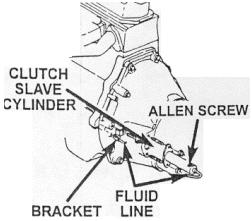Note: Tip 3 is the only one that applies to a Ram pickup
TIPS FROM AUTOMOTIVE PRODUCTS, INC.
Automotive Products, Inc., the supplier of the Pre- filled Hydraulic Clutch Actuator Assembly for the Dodge Ram (BR), the Dodge Dakota (AN), the Jeep Wrangler (TJ), and the Jeep Cherokee (XJ), has some valuable tips for Automotive Technicians pertaining to the components that they supply to DaimierChrysier.

Tip 1
There is a slave cylinder fluid leak issue occurring to 98 MY and 99 MY TJ and XJ models in the field. The symptom is a leak that is found where the clutch meets the slave cylinder (the end of the tube is wet with brake fluid). However, it has been discovered that the system is not leaking from the tube, but actually from the Allen screw (See Illustration) located at the top of the slave cylinder body. The reason it is leaking from this location is because the screw is loose. The leak can be remedied by simply tightening the Allen screw. Use extreme caution when tightening this screw because it is a metal screw with plastic threads and it is very easy to strip them (which will in turn cause a leak). It is recommended that you finger tighten the screw then give it about a 1/8 -1/4 turn with an Allen wrench. Beginning in August'99, the supplier will be removing this screw from the design and this particular failure should no longer be a problem.
Tip 2
There is another clutch noise issue occurring on the 98-99 MY TJ and XJ models in the field. The symptom is clutch pedal squeak. The squeak is a low pitch noise and sounds a lot like a low volume goose honk and can be heard whether the engine is running or off. It has been discovered that the squeak is not coming from the clutch hydraulics but instead from the release bearing and release [ever. The release lever contacts the face of the release bearing allowing a slip/stick condition between the face of the bearing and the release lever. This condition can be eliminated by greasing the release lever where it contacts the face of the release bearing.
Tip 3
If a customer complains of a soft pedal or a hard-to-shift concern, here are some diagnostic steps you can take. First, have someone actuate the clutch pedal while the technician checks the system for leaks. Next, check the fluid level in the master cylinder reservoir. If the fluid level is okay and there are no leaks to be found, try this little tip. Have someone push the clutch pedal to the floor and hold it while the technician measures the movement of the slave cylinder push rod. This can be done from the inspection hole in the dust cover using a small metal ruler. Then write down your measurement. The following is a list of the MINIMUM travel of the slave cylinder push rod needed to actuate the clutch properly:
Most likely, you will be able to measure much more than this but be rest assured that these specifications have been taken right from the blue print and they are for a worn clutch with high system pressures. If you can measure at least this amount, than the clutch hydraulics are definitely functioning correctly. Therefore, you may want to check the clutch components or, in the case of a hard-to-shift complaint, there may be a faulty transmission. This entire procedure takes about 10-15 minutes to complete

